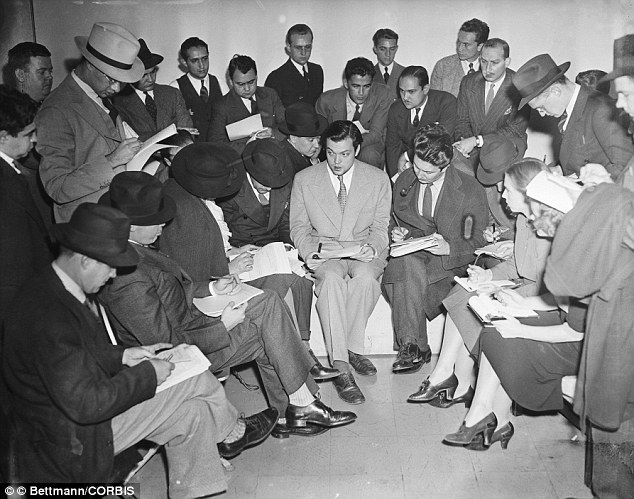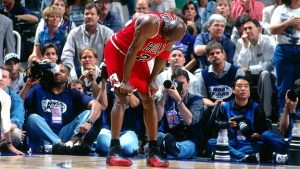Winner of the Fall 2016 StMU History Media Award for
Best Introductory Paragraph
“At least forty people, including six state troopers, lie dead in a field east of Grover’s Mill, New Jersey, their bodies burned and distorted beyond recognition.”1 These were the words heard on the night of October 30, 1938 in homes all over the United States. It was the night before Halloween and the Mercury Theatre on the Air radio show wanted to give listeners a fright in celebration of the upcoming holiday.2 What was meant as a scary story in good fun, sent the listeners of the broadcast into a full blown panic.

The live on air radio production was an adapted story from H.G. Wells’s famous novel, The War of the Worlds. In the novel, the setting takes place in England, and a league of alien spaceships, first thought to be shooting stars and meteors, begin to land. People in the surrounding area grow curious, and decide to venture out and see what all the commotion is. As a man approaches one of the meteors, he realizes it is in fact not a meteor but a hollowed out cylinder. Soon a hatch on the cylinder begins to open and a huge, disgusting creature with long gray tentacles emerges. People begin to flee their homes and panic spreads throughout the town and later throughout England. The aliens attack for weeks, feeding on the blood of humans until finally meeting their deadly fate and falling victim to human bacteria.3

Actor and filmmaker Orson Welles teamed up with one of Mercury Theartre’s writers, Howard Koch to broadcast the show over the CBS radio network. Listeners were enjoying dance music when their program was suddenly interrupted by a report of a meteorite landing. To make the story even more believable, Koch decided to alter the script and changed the location from England to a small village in New Jersey.4 Much of the rest of the story was unchanged and there were “reports” of huge creatures wreaking havoc on the town and killing people with their death rays and poisonous gas. Koch took the story even further and had an actor play the part of a reporter who was live in Time Square and reporting the devastation and destruction of New York City before falling dead himself at the microphone due to an alien attack.5 Another actor on the show who was asked to play an anonymous politician, was able to alter his voice in such a way as to sound almost identical to President Theodore Roosevelt. The “politician” declared a state of emergency and stated that troops were being sent in to help stop the invaders.6

It may seem peculiar that anyone would believe this story as factual, but that is exactly what happened. Koch was careful to make sure there were no commercial interruptions during the program to lend even more authenticity to the special report. There were reports of people all over the East Coast fleeing their homes and some adorned with gas masks remembering that the masks had once been used as a defense against gas warfare in WWI.7 Two geologists from Princeton rushed to the site of the reported meteor landing to get their hands on samples, only to find all was well in the area.8 Radio and newspaper stations were flooded with inquiries about the events reported, demanding to know what was happening. Why would anyone allow themselves to become worked up over a little scary story such as this? To answer that question, one must simply look at the events throughout history prior to and those that transpired during the early 1930s.
The stock market crash of 1929 opened the doors to the Great Depression, which was a time when America saw rates of high unemployment, lower salaries, and increased poverty. In 1937 the German airship, Hindenburg, sailed from Frankfurt, Germany to New Jersey and exploded upon its arrival, killing 36 of its crew and passengers. Between 1934 and 1937, the Midwest experienced a period of drought, loose soil, and high winds resulting in the Dust Bowl, leaving thousands of farmers without crops or livestock for several years. War machines being created in both Germany and Japan caused rising tensions, and people throughout the world were on high alert for a possible attack. The Munich Crisis had recently been broadcast by radio throughout America, and citizens were on alert for invasion.9

Taking into consideration all that had recently transpired in America, one can see why a story of invasion was taken seriously and how it could easily send the country into panic. Sociologist Hadley Cantril said it best when he described the actions of the American people as “anxiety latent in the general population caused by years of economic depression.”10 Even though listeners were told four times during the broadcast that what they were hearing was a dramatization of Wells’s famous novel, the American people were already in such a panic, most did not even hear those words.
Unlike today, news was delivered much slower in the 1930s. People did not have access to social media the way we do today. The War of the Worlds radio broadcast linked Orson Welles to the greatest hoax in the history of broadcasting at the time. If something such as this were to happen in the news today, with the limitless sources to media available, the story would be quickly exposed as the fictional tale it is. The Federal Communications Commission investigated the program, but no laws had been broken and the Mercury Theatre faced no charges. The program had done its job and terrified the American people. At the time the show aired, Americans were still on edge about the possibility of war and this show exposed the fragility of American life.
- Alan Brinkley, American History: Connecting the Past Volume 2, 15 edition (New York: McGraw-Hill Education, 2014), 696-697. ↵
- Funk & Wagnalls New World Encyclopedia, 2016, s.v. “War of the Worlds.” ↵
- Salem Press Encyclopedia of Literature, January 2015, s.v. “The War of the Worlds by H. G. Welles,” by Carl Rollyson. ↵
- Richard Cavendish, “Martians Invade New Jersey,” History Today 58, no. 10 (October 2008): 13. ↵
- Brinkley, American History: Connecting the Past Volume 2, 696-697. ↵
- Richard Cavendish, “Martians Invade New Jersey,” History Today 58, no. 10 (October 2008): 13. ↵
- Brinkley, American History: Connecting the Past Volume 2, 696-697. ↵
- James Naremore, “Who Caused the Mars Panic,” Humanities 24, no. 4 (July 2010): 38-39. ↵
- Salem Press Encycolpedia, January 2016, s.v. “Analysis: On the War of the Worlds Radio Broadcast,” by George Dixon. ↵
- James Naremore, “Who Caused the Mars Panic,” Humanities 24, no. 4 (July 2010): 38-39. ↵



37 comments
Edelia Corona
5/5 stars! You did a wonderful job giving us the full summary on the fictional attack and then giving us a background on the American people’s insecurities during that time. It’s actually pretty funny that people would believe this because it sounds ridiculous. Alien invasion? Really? But then again the radio host went through a lengthy process to make it sound as believable as possible. It also comes to show that people only hear what they want to hear. The radio host told listeners repeatedly that the events described were false and people still went on full panic mode. Thank you for posting!
Aurora Torres
Wow! I never heard about this……but than again if I lived in that era I would go crazy if we were being attacked. It’s so funny that they would broadcast over and over again that it was not real, but people did not hear that because they were so caught up with the story. Well’s did a great job capturing the audience attention and actually made them believe of this attack when all he was doing was acting the part. Great article.
Sergio Avila Roque
This was a great read. I had no idea that Orson Wells was also an actor. For some reason I was under the impression that he just wrote the novel but upon further investigation it turns out he was also the narrator of the broadcast and he would later go on to become a film maker as well. Its crazy the amount of influence the media can have on people, something’s don’t ever really change huh?
Mariana Sandoval
I loved your article! It flowed really well and was super interesting. I knew nothing about this incident. I also liked how you included a primary source images (the newspaper with the headline about the incident and the picture of the rehearsal). I understand that the American people were already anxious because of all the unfortunate events that were going on in the 1930s and the decades before, however, I find it interesting that they believed that aliens were invading.
Celina Resendez
Yes, I also was a little…okay a lot surprised that people would overreact to this! Really? An alien invasion? But I suppose you never know how you might react when anxiety is high and war is always just around the corner. I guess for them, it wasn’t so far fetched!
Vanessa Carrillo
To think that this was all about a story to scare people during Halloween time. This was a really good read. The fact that they could deliver this story over the radio and create such a panic, although kind of comical how they reacted, to feel that this was going on really made the story. The article flowed very nicely and good explaining how the people felt.
Mehmet Samuk
I really liked your article. It was interesting and I also had a curiosity to see what is coming next throughout the article. I am surprised how people overreacted to a radio broadcast but analyzing the sociological issues gives the answer. You explain well the tension throughout the American society.